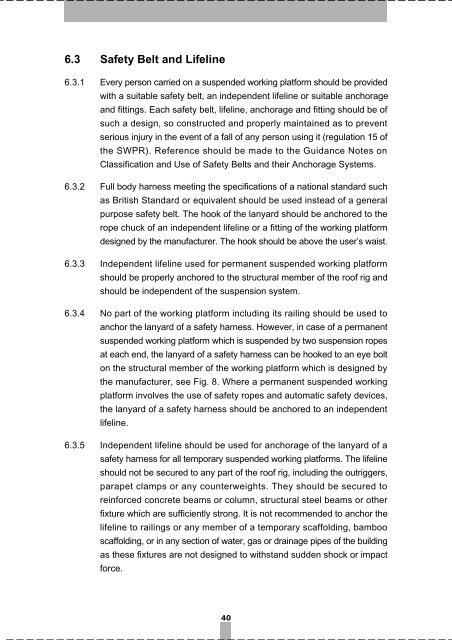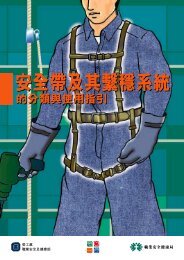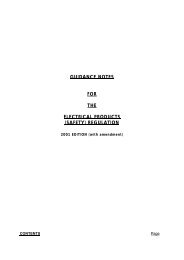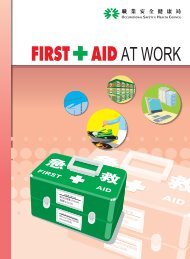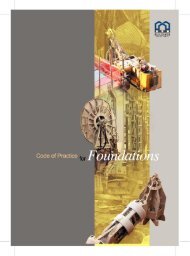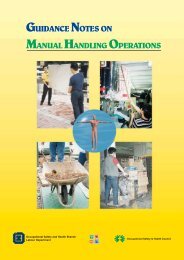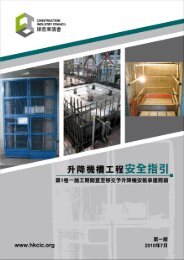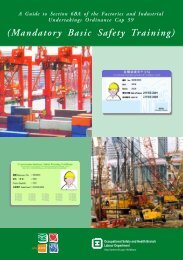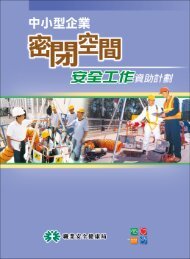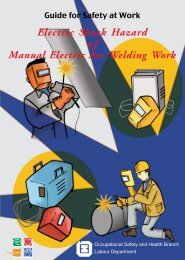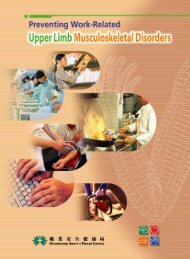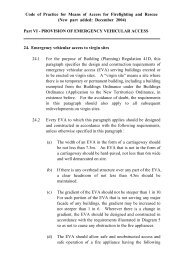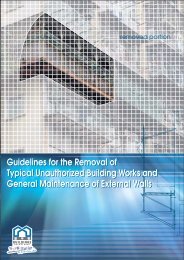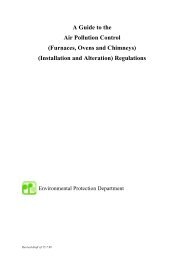Code of Practice for Safe Use and Operation of Suspended Working ...
Code of Practice for Safe Use and Operation of Suspended Working ...
Code of Practice for Safe Use and Operation of Suspended Working ...
- No tags were found...
You also want an ePaper? Increase the reach of your titles
YUMPU automatically turns print PDFs into web optimized ePapers that Google loves.
6.3 <strong>Safe</strong>ty Belt <strong>and</strong> Lifeline6.3.1 Every person carried on a suspended working plat<strong>for</strong>m should be providedwith a suitable safety belt, an independent lifeline or suitable anchorage<strong>and</strong> fittings. Each safety belt, lifeline, anchorage <strong>and</strong> fitting should be <strong>of</strong>such a design, so constructed <strong>and</strong> properly maintained as to preventserious injury in the event <strong>of</strong> a fall <strong>of</strong> any person using it (regulation 15 <strong>of</strong>the SWPR). Reference should be made to the Guidance Notes onClassification <strong>and</strong> <strong>Use</strong> <strong>of</strong> <strong>Safe</strong>ty Belts <strong>and</strong> their Anchorage Systems.6.3.2 Full body harness meeting the specifications <strong>of</strong> a national st<strong>and</strong>ard suchas British St<strong>and</strong>ard or equivalent should be used instead <strong>of</strong> a generalpurpose safety belt. The hook <strong>of</strong> the lanyard should be anchored to therope chuck <strong>of</strong> an independent lifeline or a fitting <strong>of</strong> the working plat<strong>for</strong>mdesigned by the manufacturer. The hook should be above the user’s waist.6.3.3 Independent lifeline used <strong>for</strong> permanent suspended working plat<strong>for</strong>mshould be properly anchored to the structural member <strong>of</strong> the ro<strong>of</strong> rig <strong>and</strong>should be independent <strong>of</strong> the suspension system.6.3.4 No part <strong>of</strong> the working plat<strong>for</strong>m including its railing should be used toanchor the lanyard <strong>of</strong> a safety harness. However, in case <strong>of</strong> a permanentsuspended working plat<strong>for</strong>m which is suspended by two suspension ropesat each end, the lanyard <strong>of</strong> a safety harness can be hooked to an eye bolton the structural member <strong>of</strong> the working plat<strong>for</strong>m which is designed bythe manufacturer, see Fig. 8. Where a permanent suspended workingplat<strong>for</strong>m involves the use <strong>of</strong> safety ropes <strong>and</strong> automatic safety devices,the lanyard <strong>of</strong> a safety harness should be anchored to an independentlifeline.6.3.5 Independent lifeline should be used <strong>for</strong> anchorage <strong>of</strong> the lanyard <strong>of</strong> asafety harness <strong>for</strong> all temporary suspended working plat<strong>for</strong>ms. The lifelineshould not be secured to any part <strong>of</strong> the ro<strong>of</strong> rig, including the outriggers,parapet clamps or any counterweights. They should be secured torein<strong>for</strong>ced concrete beams or column, structural steel beams or otherfixture which are sufficiently strong. It is not recommended to anchor thelifeline to railings or any member <strong>of</strong> a temporary scaffolding, bambooscaffolding, or in any section <strong>of</strong> water, gas or drainage pipes <strong>of</strong> the buildingas these fixtures are not designed to withst<strong>and</strong> sudden shock or impact<strong>for</strong>ce.40


